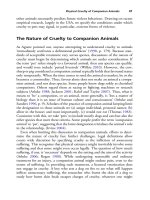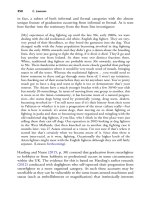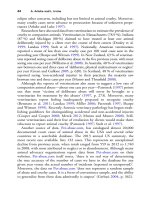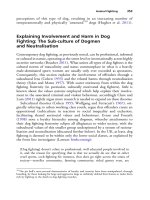The palgrave international handbook of a 171
Bạn đang xem bản rút gọn của tài liệu. Xem và tải ngay bản đầy đủ của tài liệu tại đây (28.11 KB, 1 trang )
Breeding and Rearing Farmed Animals
163
7.75 lb. (Fine et al. 2006, pp. 207–208). While the bodies and minds of
chickens endured intensely overcrowded, barren and polluted conditions,
the post-war boom in the chicken business attracted the attention and
investment of large pharmaceutical companies which developed treatments
for diseases and ‘unwanted’ chicken behaviour.
Following the successful intensification of chicken-meat and chicken-egg
production, the 1960s saw the development of intensified and highly automated systems for growing other birds, pigs, cattle and sheep. Key to success
were automated feeding and watering systems, and for indoor raised animals,
the elimination of bedding and litter through development of different kinds of
food conveyance systems, cages, stalls, pens, forms of restraint and slatted floors
over gutters or holding pits. Intensification has been applied to animals raised
outdoors, and the cattle ‘feedlot’ of the USA is the strongest example of this.
Feedlots are fenced in areas with a concrete feed trough along one side and were
developed in the context of depleting soil through overgrazing and surplus corn
production, from the early years of the twentieth century. With nothing else to
do, and stimulated by growth promoting hormones, contemporary feedlot
cattle eat corn and soya, which may be ‘enhanced’ with the addition of growth
promoting additives such as cardboard, chicken manure, industrial sewage,
cement or plastic feed pellets (Rifkin 1994, pp. 12–13). Slightly less barren and
automated are the cattle ‘stations’ predominant in Australia and Central and
South America (Nibert 2013, pp. 142–153). Increased demand for cheap meat
(primarily for consumption by social elites) has also led to the establishment of
indoor production systems in poorer countries. Battery systems for laying hens
and the growing of chickens in broiler units are now widespread throughout
the Indian sub-continent (Macdonald 2010).
Thus the breeding and raising of non-human animals has been an historical development exploitative of land and of both non-human animal and
human labour and has been embedded in patterns of global inequality. The
abusive treatment of non-human animals farmed for food has been a backdrop to this tale of global networks and practices thus far, and in the next
section we turn to focus on the treatment of different kinds of farmed animal
in the processes of breeding and rearing.
Nature
There is much evidence that the animals we breed and rear for food—sheep,
goats, cattle, chickens, turkeys, ducks, geese and pigs—have complex emotional lives and are individuals with views about their worlds (Masson 2004).









